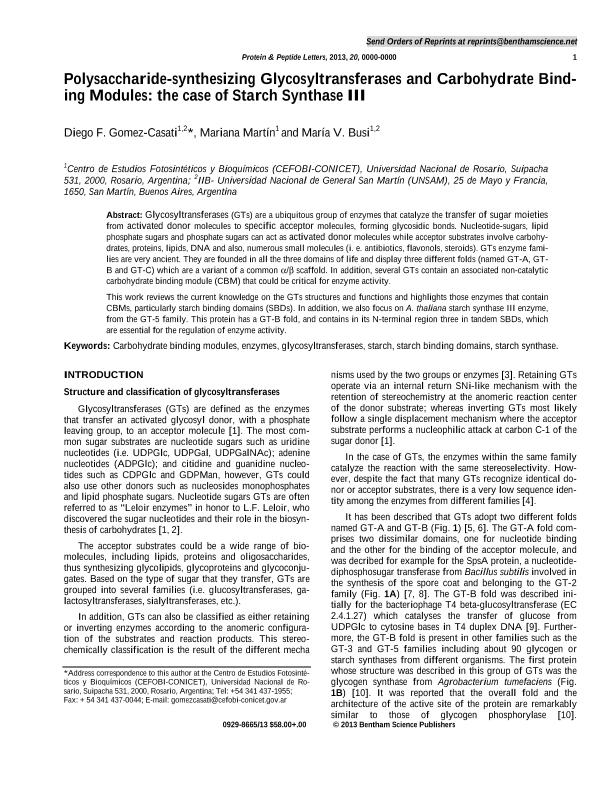Artículo
Polysaccharide-synthesizing Glycosyltransferases and Carbohydrate Binding Modules: the case of Starch Synthase III
Fecha de publicación:
05/2013
Editorial:
Bentham Science Publishers
Revista:
Protein And Peptide Letters
ISSN:
0929-8665
Idioma:
Inglés
Tipo de recurso:
Artículo publicado
Clasificación temática:
Resumen
Glycosyltransferases (GTs) are a ubiquitous group of enzymes that catalyze the transfer of sugar moieties from activated donor molecules to specific acceptor molecules, forming glycosidic bonds. Nucleotide-sugars, lipid phosphate sugars and phosphate sugars can act as activated donor molecules while acceptor substrates involve carbohydrates, proteins, lipids, DNA and also, numerous small molecules (i. e. antibiotics, flavonols, steroids). GTs enzyme families are very ancient. They are founded in all the three domains of life and display three different folds (named GT-A, GTB and GT-C) which are a variant of a common α/β scaffold. In addition, several GTs contain an associated non-catalytic carbohydrate binding module (CBM) that could be critical for enzyme activity.<br />This work reviews the current knowledge on the GTs structures and functions and highlights those enzymes that contain CBMs, particularly starch binding domains (SBDs). In addition, we also focus on A. thaliana starch synthase III enzyme, from the GT-5 family. This protein has a GT-B fold, and contains in its N-terminal region three in tandem SBDs, which are essential for the regulation of enzyme activity.
Archivos asociados
Licencia
Identificadores
Colecciones
Articulos(CCT - ROSARIO)
Articulos de CTRO.CIENTIFICO TECNOL.CONICET - ROSARIO
Articulos de CTRO.CIENTIFICO TECNOL.CONICET - ROSARIO
Articulos(CEFOBI)
Articulos de CENTRO DE EST.FOTOSINTETICOS Y BIOQUIMICOS (I)
Articulos de CENTRO DE EST.FOTOSINTETICOS Y BIOQUIMICOS (I)
Citación
Gomez Casati, Diego Fabian; Martín, Mariana; Busi, María Victoria; Polysaccharide-synthesizing Glycosyltransferases and Carbohydrate Binding Modules: the case of Starch Synthase III; Bentham Science Publishers; Protein And Peptide Letters; 20; 5-2013; 856-863
Compartir




